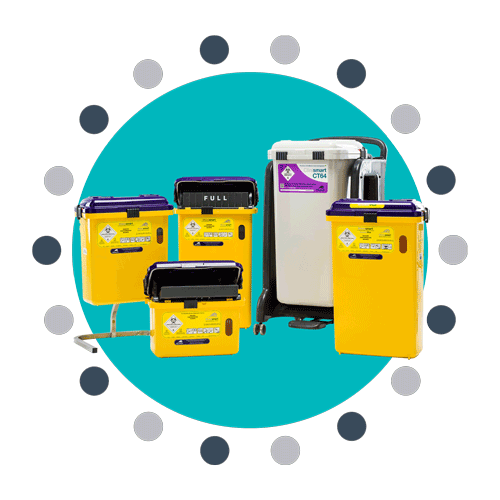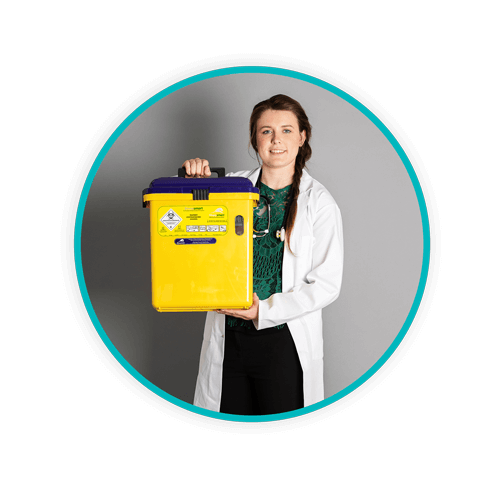What is Cytotoxic Waste?

Editor’s note: This post was originally published in September 2021 and has been updated for accuracy and comprehensiveness.
Do you know something scarier than both hazardous waste and clinical waste? You guessed it! Hazardous clinical waste, which includes cytotoxic waste…
The cytotoxic waste stream consists of some of the most dangerous drugs used in healthcare – cytostatic or cytotoxic drugs – and any materials contaminated with them. This type of clinical waste is a critical concern in healthcare settings due to its hazardous properties and poses significant health risks if mismanaged.
In this digestible guide to cytotoxic waste, we delve into the specifics of cytotoxic waste, its hazardous properties and regulations, how to reduce the risks of exposure, and more to help healthcare professionals understand the hazards associated with cytotoxic waste and ensure safety.
TOPICS WE WILL COVER:
3 / Is Cytotoxic Waste Hazardous?
4 / What Is the Risk of Exposure?
6 / Cytotoxic Waste Waste Handling and Storage
7 / What Colour Are Cytotoxic Waste Bins?
8 / Ensure Safe and Secure Cytotoxic Waste Disposal
What Is Cytotoxic Waste?
Cytotoxic waste refers to cytotoxic and/or cytostatic drugs, and materials contaminated with them – these drugs are highly hazardous and can pose significant risks to both human health and the environment if not handled, stored, and disposed of properly.
Cytotoxic drugs are also known as antineoplastics. Their basic definition defines them as a group of medicines that contain certain chemicals that are toxic to cellular structures, primarily in the prevention of growth or replication.
Whilst the terms ‘cytotoxic’ and ‘cytostatic’ are often used interchangeably, there is a subtle distinction. Cytotoxic drugs are directly toxic to cells, whilst cytostatic drugs inhibit cellular growth and division. It’s important to understand this difference, however, both can be disposed of together due to their similarities.
Both cytotoxic and cytostatic drugs are commonly used to treat cancer, they can also be used in smaller doses to suppress the immune system and reduce inflammation – making them useful for treating other conditions such as multiple sclerosis and rheumatoid arthritis.
Cytotoxic Waste Examples
Cytotoxic waste can come from various sources within healthcare settings, common examples include:
- Chemotherapy drugs: These are the most common type of cytotoxic waste, used in the treatment of cancer.
- Cytotoxic medications: Other medications, such as certain hormonal therapies.
- Contaminated materials: Items that have come into contact with cytotoxic drugs, such as syringes, gloves, and waste containers.
- Patient excreta: In some cases, the excreta of patients undergoing cytotoxic treatment may contain traces of the drugs.
Chemotherapy drugs specifically designed for the treatment of cancers include but are not limited to:
- Aldesleukin
- Bleomycin
- Carboplatin
- Dactinomycin
- Doxorubicin
- Hydroxycarbamide
- Rituximab
Some examples of non-chemotherapy cytotoxic and/or cytostatic drugs include:
Is Cytotoxic Waste Hazardous?
In short, yes. As we alluded to at the outset of this blog, cytotoxic and cytostatic wastes are classified as hazardous clinical waste under European Waste Classification (EWC) Code 18-01-08*.
This is due to this waste type containing hazardous properties of any one or more of the following:
- Carcinogenic – has the potential to cause cancer
- Mutagenic – capable of inducing genetic mutation
- Acutely toxic – may cause adverse effects from a single exposure or within a short time frame
- Toxic for reproduction – has the potential to inhibit sexual function, fertility, and reproductive organs
What Is the Risk of Exposure?
Such drugs as cytotoxic and cytostatic are not able to target a specific area of the body and have the potential to produce not only side effects to the patient undergoing treatment, but to others who may become exposed to the medicines. Settings where cytotoxic drugs are used include hospitals, hospices, care homes and even veterinary clinics.
Cytotoxic and cytostatic drugs can enter the body through skin contact, inhalation, ingestion, or needlestick injuries – leading to various health issues such as:
- Cancer
- Birth defects
- Infertility
- Respiratory problems
- Skin irritation
Those most vulnerable to exposure are healthcare workers, waste handlers, pregnant women and individuals with compromised immune systems – the healthcare professionals most likely to come into contact with cytotoxic waste are:
- Oncologists specialising in cancer treatment.
- Nurses involved in administering chemotherapy or handling cytotoxic medications.
- Pharmacists preparing and dispensing cytotoxic drugs.
- Lab technicians handling cytotoxic samples or conducting tests.
- Cleaning staff responsible for cleaning areas where cytotoxic drugs are handled or stored.
- Portering staff and waste handlers responsible for handling and moving waste.
Several activities within the healthcare setting can also increase the risk of exposure to cytotoxic waste:
- Drug preparation: Mixing, diluting, or labelling cytotoxic drugs.
- Drug administration: Injecting, infusing, or applying cytotoxic medications.
- Handling patient waste: Handling contaminated materials such as soiled linens or medical equipment.
- Cleaning spills: Cleaning up spills of cytotoxic drugs or contaminated substances.
- Transporting cytotoxic materials: Moving cytotoxic waste between different locations.
- Disposing of cytotoxic waste: Improperly handling or disposing of cytotoxic waste.
So, with the risk of exposure covered extensively, let’s take a look at how to reduce those risks.
Reducing Exposure Risks 
Keeping yourself, your patients, and your colleagues safe within the healthcare environment hinges upon effective exposure control.
We’ve already touched on the hierarchy of controls in our blog on how to protect healthcare workers from sharps injuries, so we’ll cover some key strategies here:
- Prioritise containment: Use totally enclosed waste containment systems whenever feasible to minimise exposure.
- Implement source control: Ensure you’re prepared and equipped to dispose of any cytotoxic or cytostatic waste at the point of generation and use adequate extraction systems alongside the correct organisational measures to reduce the release of cytotoxic substances into the workplace.
- Employ personal protective equipment (PPE): When other controls are insufficient, ensure you have access to the appropriate PPE.
- Minimise exposure: Reduce the quantity of drugs used. Limit the number of staff exposed, and shorten exposure durations as much as possible.
- Ensure safe handling and storage: Implement efficient protocols for the safe handling, storage and transportation of cytotoxic drugs and related waste.
- Maintain high hygiene standards: Prohibit eating, drinking, and smoking in areas where cytotoxic drugs are handled and provide adequate welfare and washing facilities.
- Provide comprehensive training: Educate staff on the risks associated with cytotoxic waste, proper handling techniques, and safety precautions.
Cytotoxic Waste Handling and Storage
Proper handling and storage of cytotoxic waste in line with the Health Technical Memorandum (HTM) 07-01 is crucial for preventing exposure and ensuring compliance with regulations.
The key guidelines cover:
- Segregation: Separate cytotoxic and cytostatic waste from other clinical waste streams to prevent contamination and ensure proper disposal.
- Storage: Store cytotoxic and cytostatic waste in designated containers or areas that are secure, well-ventilated, and clearly labelled.
- Labelling: Accurately label containers with the type of waste and the producer’s information and use appropriate hazard symbols.
- Transportation: Ensure cytotoxic waste is transported by certified waste transporters using approved methods and packaging that comply with transportation regulations.
- Disposal: Dispose of cytotoxic waste through authorised, licensed disposal facilities.
What Colour Are Cytotoxic Waste Bins? 
When it comes to hospital waste colour coding, the colour to remember for cytotoxic waste is purple.
According to the HTM 07-01, the packaging requirements for cytotoxic and cytostatic waste differ slightly depending on the characteristics of the waste:
- Cytotoxic and cytostatic medicines: Whether inside or outside of their original packaging must be disposed of in purple-lidded or purple-labelled rigid containers – one is typically labelled for solids and another for liquids.
- Cytotoxic and cytostatic sharps waste: Sharps waste that has been medicinally contaminated with cytostatic or cytotoxic medicines should be disposed of in a purple-lidded sharps receptacle.
- Other cytotoxic (soft) waste: Can be disposed of using purple striped clinical waste bags or Sharpsmart’s reusable bagless cytotoxic waste containment system which has a purple lid, or in the case of our 64-litre containers, a colour-coded sticker.
Note: if the properties of any medicine are difficult or cannot be determined, err on the side of caution and classify that waste as cytotoxic and cytostatic.
Always ensure that appropriate containers and receptacles are readily available for cytotoxic waste disposal and remember, point-of-care disposal is the most efficient way to segregate correctly and improve safety.
By following these guidelines for cytotoxic waste handling, storage and disposal, you can significantly reduce the risks associated with this waste stream and ensure compliance with regulatory requirements.
Ensure Safe and Secure Cytotoxic Waste Disposal
Knowledge of the difference between the various healthcare waste streams is vital for safety and compliant segregation and disposal processes.
That’s why at Sharpsmart, we go much further than the waste yard! We acknowledge that successful waste segregation is at its best when all staff are properly trained and have the right equipment – we work within the four walls of your organisation to ensure the best clinical outcomes are achieved.
Keep your fellow healthcare professionals and patients safe and your waste management compliant by partnering with Sharpsmart.
Contact us to get started with our cytotoxic waste disposal services.
Let's Talk!
Your time is valuable, and we don’t want to play hard to get. You can either phone us directly on the details listed on our contact page, or feel free to fill out this short form and one of our team members will get back to you as quickly as possible.
